The Unique Alliance of Saab Cars and Mountain Police: A Tale of Innovation and Advertising

In the picturesque mountain towns of Vail and Aspen , Colorado, a unique story unfolded over decades, highlighting an innovative approach to law enforcement vehicle needs and advertising brilliance. This narrative begins in the early 1970s and extends into the 1980s, featuring Saab automobiles —a brand renowned for its engineering prowess, especially in challenging driving conditions. Table of Contents The Genesis of a Unique Partnership The story took off on March 15, 1974, when the local media outlet “Vail Daily” reported an unconventional initiative. Vail welcomed its first SAAB police vehicle as part of an experimental program, where police departments would test SAAB vehicles in exchange for advertising rights. This ingenious idea was the brainchild of Vail Police Officer Joel Meriwether, a visionary with prior experience in similar endeavors in Florida. As a former Mazda dealer, Meriwether had previously facilitated a program for the Orlando Police Department, supplying vehicles for testing in exchange for advertising opportunities. Vail’s police department was in dire need of new vehicles at the time. Recognizing this, Meriwether spearheaded the exploration of a local police vehicle program akin to his Florida project. SAAB Denver, Inc. quickly showed interest in this innovative partnership, marking the beginning of a long-standing relationship between the ski towns of Vail and Aspen and Saab automobiles. A Tradition of Reliability in Snowy Climes The selection of Saab vehicles by the police departments of Vail and Aspen was no coincidence. Saab’s reputation for outstanding performance in snowy conditions made them an ideal choice for these ski resort towns, where driving conditions can be particularly challenging due to heavy snowfall. This practical choice underscored the towns’ commitment to ensuring that their law enforcement could reliably perform their duties, regardless of the weather. Marketing Genius: Beyond the Snowy Roads By November 5, 1982, Saab’s unique partnership with the Vail and Aspen police departments had evolved into a clever marketing campaign. Advertisements featuring Saab vehicles, slated to appear in major newspapers like the Philadelphia Inquirer, the Seattle Times, and the Washington Post, highlighted the police departments’ exclusive use of Saab cars. The ad cleverly noted, “ In Aspen and Vail, ski conditions are usually terrific. Which means driving conditions aren’t.” This marketing strategy ingeniously leveraged the practical aspects of the partnership to showcase Saab’s reliability in adverse conditions. However, the creation of these ads revealed a creative and somewhat humorous behind-the-scenes effort. The Saabs pictured were, in fact, the same car with temporary Vail and Aspen logos. The snow depicted was not real but rather about 50 pounds of shredded Styrofoam, and the photoshoot took place not in Colorado but in a diner parking lot in New Jersey. Moreover, the supposed Aspen officer featured was not a real officer but an illustrator, highlighting the lengths to which the advertising agency went to create a compelling narrative. Legacy of Innovation and Partnership The Saab and Vail/Aspen partnership stands as a testament to the power of innovative thinking and strategic collaboration. It wasn’t just about providing the police with capable vehicles; it was a synergistic relationship that also served as a powerful marketing tool. This story illustrates how thinking outside the box—whether in solving practical problems like vehicle needs or in crafting compelling advertising campaigns—can lead to memorable and impactful outcomes. As we look back on this unique chapter in automotive and law enforcement history, it’s clear that the legacy of Saab cars in these mountain communities was about more than just driving through snow. It was about pioneering partnerships, creative marketing, and the enduring bond between these towns and a car brand that helped keep their streets safe and their identities distinct.
